Strategic siting is integral to determining the total cost of ownership and the facility’s life span.
by RONALD BOWMAN & TERENCE DENENY, Structure Tone Mission Critical
In today’s data center conversation, there is considerable discussion of ideal topology, clean power, cost per MW, network connectivity (latency) and a myriad of “flavor of the month” issues. The dialog is wide ranging because data center facilities are complex, technology changes rapidly and owners/operators have disparate needs
Site selection is also a highlight in discussion of data center drivers today. Strategic siting is integral to determining the total cost of ownership (TCO) and, to a significant degree, life span of a data center.
The right solution is the result of close collaboration between all stakeholders — including IT, real estate, facilities and finance — from the project’s inception. In addition, siting success is dependent on 360º solutions that start with strategic planning and carry through day-two support, including:
- Location/site selection strategy
- site due diligence
- purchase, lease and build-to-suit negotiations
- financing strategies
- business and economic incentive negotiations
- construction management services.
The Evaluation Factors
Eight primary categories are investigated when evaluating a site. A brief discussion of each is included below.
Environment is assessed for risk and exposure to natural disasters. Areas that are prone to such risks (seismic vulnerability, extreme weather events, flood plain jeopardy) are typically assigned a higher risk factor and, thus, are generally excluded from consideration.
Further, temperate climates are a growing subset of the environmental factor. These locations provide options for 100-percent outside air (free) cooling or air-water economization — thus driving down PUE (power usage efficiency), a major consideration in data centers today.

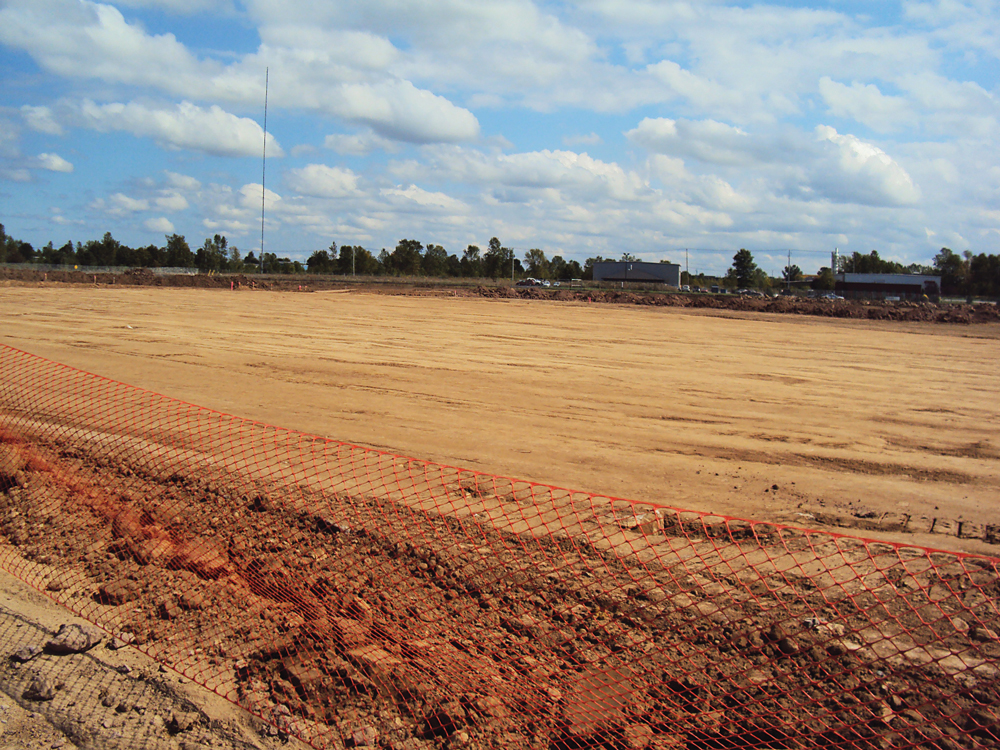
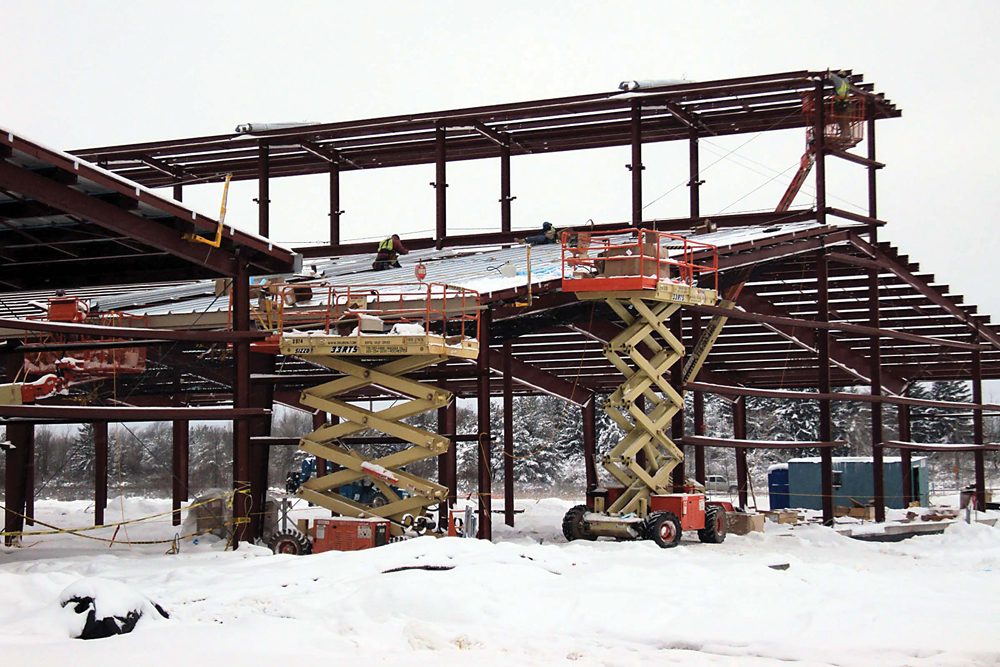
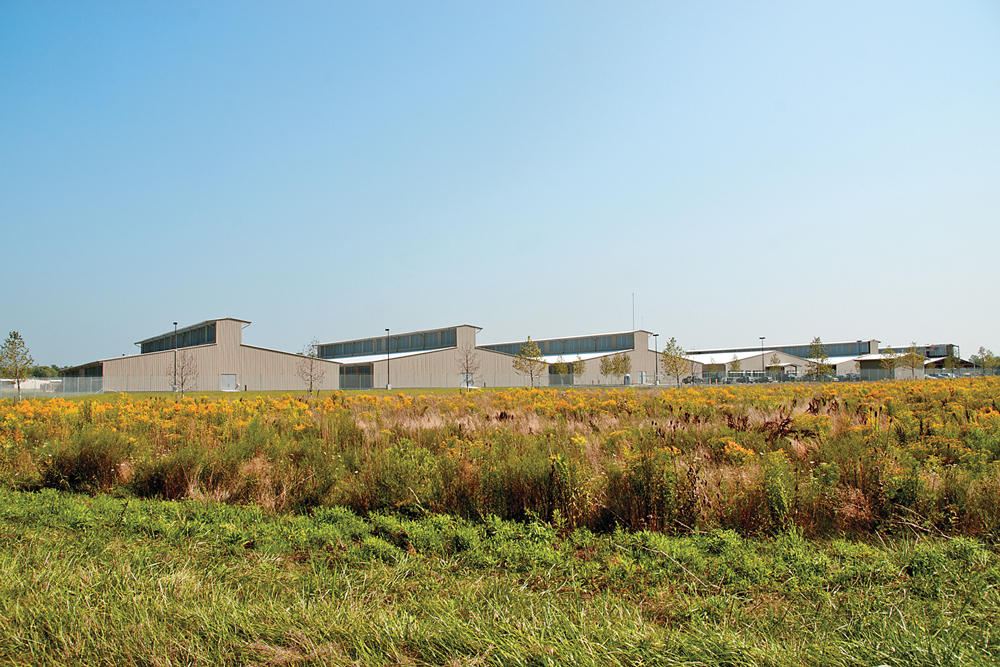
This 184,000 -sq.-ft. data center for Yahoo! was built on a greenfield site near Buffalo, N.Y. (See the Nov. ‘09 issue of Site Selection.) It is a 20-megawatt facility cooled with 100 percent outside air utilizing an adiabatic cooling solution that takes advantage of natural hot and cold air flow dynamics.
Images courtesy of Jim Bush, Courtesy Structure Tone Mission Critical
Power encompasses analysis of the availability, type, and growth plans of the local utility. Power is typically one of the highest on-going costs of operating a facility. It is critical to understand the pricing architecture, stability and/or volatility of the local utility market, as well as the mix of generation options.
Clean power is also a key criterion in the site selection process. Data center owners/operators seek reliable, efficient renewable energy options such as hydro, air, wind and, to a lesser degree, solar. Fuel cells are also emerging as a viable power option. These alternatives address a growing need to be more eco-conscious and to reduce grid dependency.
Fiber network connectivity, which determines latency (transaction time) between the potential site and key points-of-presence, is a major site evaluation factor. Understanding latency limits and the location of preferred fiber providers and telecommunication points-of-presence in advance of identifying sites increases the overall success of the site selection process. This entails working with the owner’s/operator’s network administrator(s) to establish requirements for connectivity and applying those criteria to potential sites.
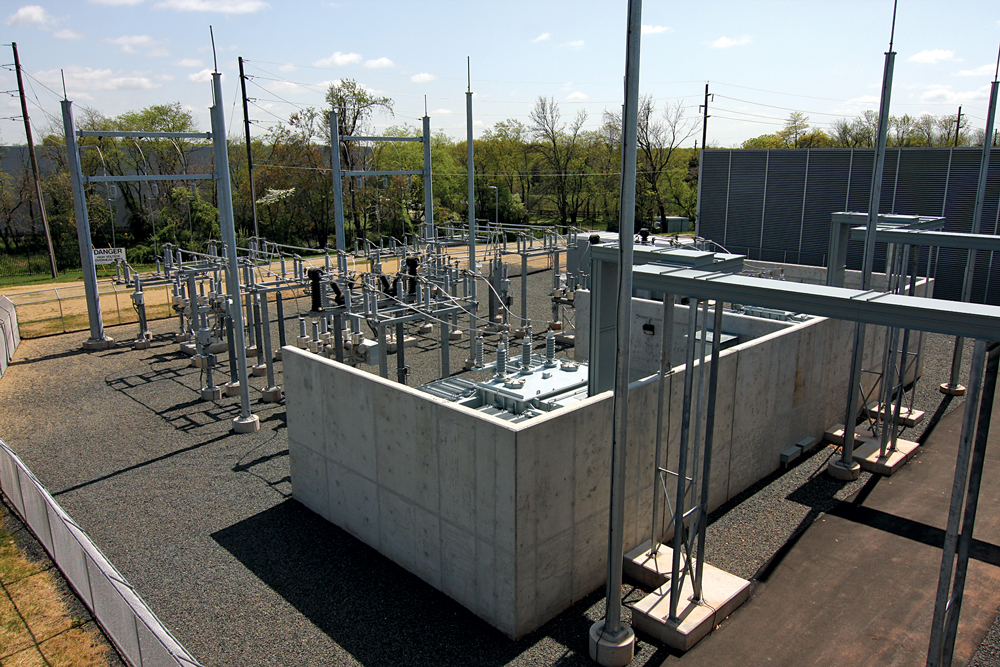
Power availability from local utilities is a key driver in data center site selection. On site utility yards are often constructed in conjunction with the data center to support the high energy demands of the facility.
©John Baer_PDM Pictures, Courtesy Structure Tone Mission Critical
Taxes, land and economic incentives play a key role in the site evaluation process. Taxes may include sales, personal property and real estate. Land costs largely mirror those for personal real estate — higher on the coasts and near urban centers and lower in the central U.S. or rural areas. Incentives are user and site specific and are often tied to a vital public message regarding job creation and community investment on the part of the data center owner/operator. As with most commercial enterprise, development of a data center often translates to employment and revenue (both tax and B-to-B) for the community. Economic development agencies may offer economic incentives (such as competitive energy costs or reduced sales tax on major equipment) to secure these benefits.
Transportation is a site evaluation factor that requires astute analysis. Proximity to prime corridors can be viewed as both favorable and unfavorable. Access to major transportation modes, such as airports, rail lines and interstate roadways, creates the potential for increased risk should a disaster occur on or at the transportation link. Conversely, the ability to provide employees, vendors and suppliers timely and direct access to respond effectively to events is also paramount.
Construction and permitting costs are key parts of the site selection equation that can be evaluated based on several factors, including proximity to critical infrastructure, availability of qualified construction labor, and existing geological conditions. These factors contribute to the certainty, or uncertainty, of the cost and schedule to build the data center.
Sites that are isolated from existing public utilities, or have extreme topographic or geologic conditions, can substantially increase cost. Availability, or lack thereof, of qualified labor can affect schedule (as well as quality) — and time is money. In addition, the permitting strategy and timelines associated with securing proper authorizations, including public notifications and hearings, can increase the overall schedule. Local and state regulations are an important consideration in evaluating a site.
Labor, while usually a minimal consideration given the weight of other drivers (data centers typically employ fewer than 100 employees), should not be overlooked. This factor can be easily assessed by an examination of skilled IT workers within reasonable commuting distance (60-90 minutes) of a potential site.
Speed to market (go live date) defines the data center. The date that the facility needs to be operational is critical. All of the above need to be factored for impact to the go-live date and what, if any, special consideration(s) each may require to achieve the schedule. A detailed schedule outlining key processes and critical milestones must be rigorously monitored to consistently drive all project stakeholders to the common goal of achieving the schedule.
The Process
Critical actions take place long before any site visits. The owner/operator and its consultant must clearly delineate the requirements for each category prior to the start of the search. Together, stakeholders must achieve a detailed understanding of the risk tolerance that the owner/operator is willing to accept for any given criterion. This will increase the likelihood of finding a suitable site more efficiently while reducing distractions from sites that do not meet defined requirements.
As sites are identified, a detailed evaluation matrix of primary and secondary categories is used to vet locations. Sites are then assigned a weighted score based on compliance with all criteria. Sites that meet or exceed a predetermined acceptable score are selected for further investigation.
Once preliminary analyses are complete, it is time to “kick the dirt.” Site visits and meetings with municipal officials, telecomm/fiber and local utility providers, and Authorities Having Jurisdiction (AHJ) provide a level of insight that cannot be achieved through phone conversations, online maps or economic development promotional materials.
Short-listed sites are vetted with key stakeholders. Locations are further investigated (phase one environmental and geotechnical studies, title/deed searches, confirmation of utility capacities, etc.) to confirm that information collected to date is accurate. It is at also at this point that conversations between local officials and the owner/operator commence regarding potential tax, property, and economic incentives.
As sites are narrowed down, constructability reviews encompassing cost estimate, schedule and logistics are prepared. These provide a means to determine unique impacts that the site will have on project delivery.
The final step is a detailed analysis and ranking of sites, including a recommendation, for consideration and approval by key stakeholders.
The Ultimate Goal
Siting and building data centers is a unique and challenging endeavor. Each owner/operator has different short and long-term strategic drivers. This is exacerbated by an industry that redefines focus very three to five years and fully morphs every seven to 10. In addition, most assets are amortized over a 15- to 18-year useful life of critical infrastructure. Taking all this into account requires a site selection and construction manager that brings insight and proven methods that are a confluence of veteran experience and up-to-the-minute market awareness to plan and evaluate optimal, scalable solutions.


Ronald Bowman (left), Executive Vice President, and Terence Deneny, Vice President, lead Structure Tone Mission Critical, a complete data center solutions provider that has managed siting and construction of over 23 million sq. ft. of white space.
Utah: The (Virtual) Crossroads of the West
Data is everywhere, woven into the fabric of our everyday lives and driving our business decisions. Data is everywhere, but it needs a home. Thanks to a number of attributes, Utah makes a welcoming home for data centers, data analysis, and e-commerce.
Why Utah?
Infrastructure. Consider infrastructure. Utah’s low cost of energy keeps data center operational costs in check. At about 8.6 cents per kilowatt hour, Utah stands in the top quintile of competitive energy rates — including the nation’s second lowest natural gas prices.
The low cost of energy promises to be sustained by the state’s long-term, strategic energy development plan. The plan focuses on maintaining a solid base load with abundant traditional sources like cheap natural gas and gradually implements a voluntary goal of 20 percent net electricity generation from renewable resources by 2025.
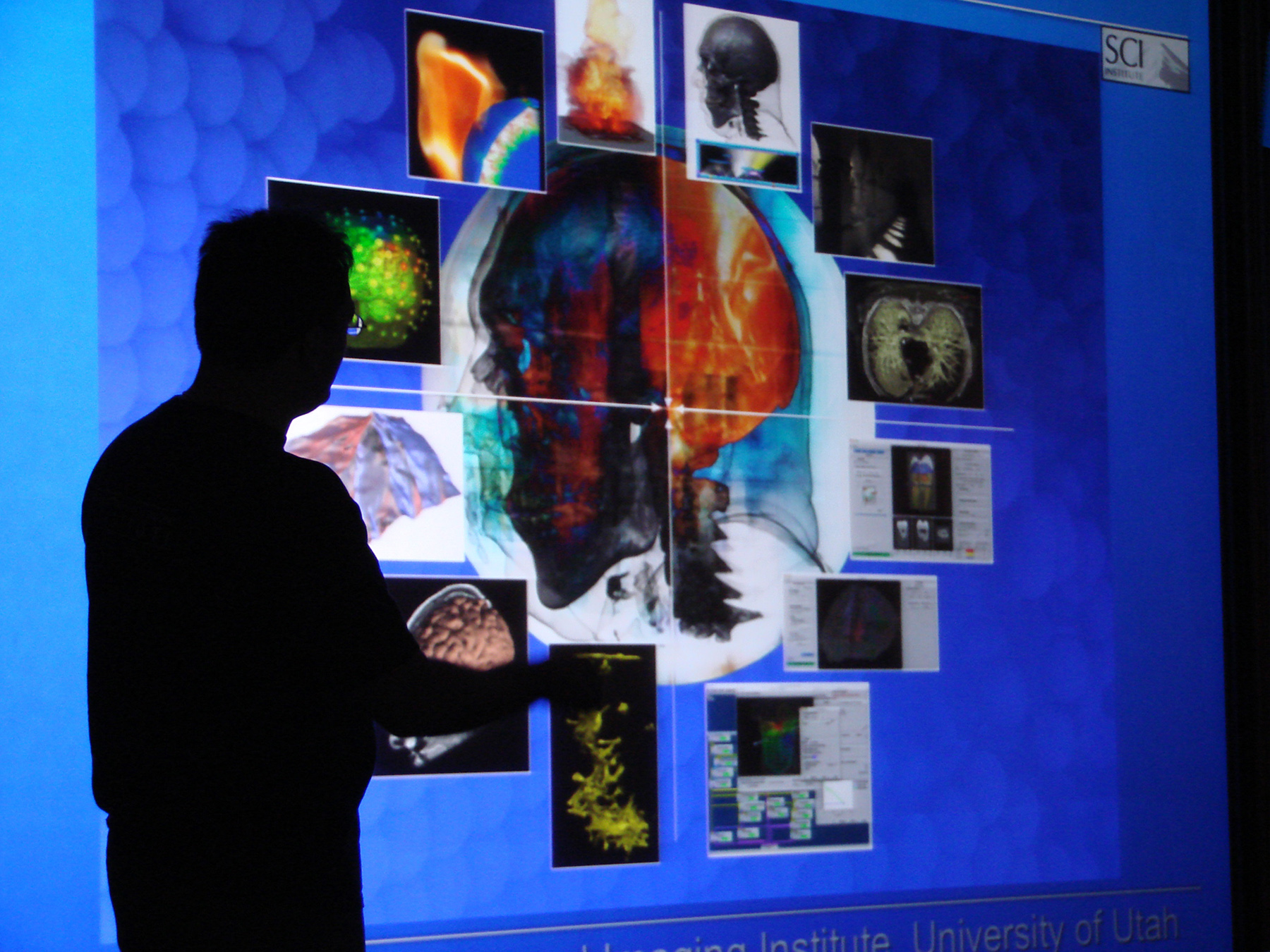
Utah’s universities are at the forefront of imaging and data management technology development (University of Utah SCI Institute).
In fact, because of Utah’s emphasis on energy development, Utah is part of the “new geography of success.” Resource-rich states like Utah are poised to power the future, and the future is full of data.
Then there is broadband, the nerve system of the Information Technology industry. Utah has the fourth-fastest broadband speed in the nation, outcompeting most other western states. Broadband speed translates to the ability to get work done in virtual offices, as well as being able to support a global customer base in support centers, such as the one eBay operates in Salt Lake County.
Workforce. Consider the skilled workforce being cultivated in Utah. Overall Utah’s workforce is among the youngest and healthiest in the nation, and a remarkable number are fluent in foreign languages. Utah’s bilingualism and global interconnectivity are helping businesses compete in the international marketplace. Utah ranked in the top five for every export index including export growth and intensity in the U.S. Chamber of Commerce’s “Enterprising States” report. It’s a startling statistic for a state without a seaport.
The University of Utah is on the cutting edge of large dataset analysis, image processing, and digital media, and has a long legacy in IT, including its role in the very birth of the Internet. In the 1980s, two of the world’s largest software companies — Novell and Word Perfect — were in Utah, and they helped lay the foundation for networking software that defines today’s business.
The U’s renowned Scientific Computing and Imaging Institute involves undergraduate and graduate students in supercomputing innovations to solve some of humankind’s most challenging problems, from analyzing deep geological formations for oil and gas to delving into the deep structure of the human brain.
Regional institutions are in the act as well, with Weber State University in the Ogden metropolitan area graduating high numbers of computer science students, and Utah Valley University in the Orem/Provo metropolitan area offering strong programs in digital media. Between public and private institutions, there are more than a dozen computer science schools in the state. Both metropolitan areas are listed among the nation’s top places for business and careers, and the nation’s most livable cities.
IT “Ecosystem.” Consider the companies already at work in Utah. Whether peak performers in online retail from Overstock to Backcountry.com or the world’s most sought-after IT and software powerhouses like Qualtrics and Adobe, Utah has established itself as a gold standard for critical data center support.
Of course, a little extra validation never hurts. So thank you, National Security Agency. Utah is also proud to provide the necessary infrastructure to support the $1.5 billion venue for some of the most sensitive data on the planet.
All things considered, some 3,770 companies across several key sub-sectors of the IT industry are outperforming the nation. From wired telecommunications to data processing and hosting to software publishers and semiconductor manufacturing, Utah’s hottest sub-sectors are helping to define the market through industry concentration in one of the nation’s most dynamic economies.
For more information, call (801) 538-8879 or visit www.business.utah.gov.
Northeast Wisconsin Offers Value to Data Center Developers
Prequalified and Prepared for Development
Northeast Wisconsin offers significant advantages of safety, security and power reliability for developers, in addition to real price point reductions available through free ambient cooling.
Twenty sites have been prequalified for necessary redundant power and telecommunications, while the region offers unique opportunities in green energy and a prepared, highly-trained technical workforce.
The 18-county region of Northeast Wisconsin, known as the New North region, recognizes Data Centers as an opportunity for development and is positioned to offer competitive value to developers.
Recognized, Real Advantages by Major Corporations in Data Center Development
“As we evaluated the global locations of our second corporate Tier 3 datacenter, Northeastern Wisconsin provided the most value for Kimberly-Clark Corporation. The climate advantage may be one of the most overlooked advantages. With our new corporate data center, half of all the operating hours in any given year provide ‘free cooling,’ ” said David L. Richter, Ph.D, Vice President, Global ITS Infrastructure & Operations for Kimberly-Clark Corporation.
Development Opportunities Await in Northeast Wisconsin
Numerous companies in the region have announced co-location interest, while several large Fortune 500 companies are already realizing development advantages offered by the region and demand additional future data center development.
Visit www.thenewnorth.com/datacenters for detailed information on resources, utilities and the twenty available, prequalified data center sites in Northeast Wisconsin.
Catawba County Embracing Innovation To Attract
Data Center and Energy Sector Investment
Bed Bath & Beyond recently joined Apple, Facebook, Google, Disney and others in NC’s Data Center Corridor.Bed Bath & Beyond’s 48,000 square foot, $37 million data center is the latest success in Catawba County’s efforts to recruit innovation-based companies. Since Catawba County began targeting recruitment of data centers by establishing the NC Data Center Corridor, the area has welcomed these very recognizable names and is providing new opportunities for others to follow.
Realizing that product drives deals, Catawba County recently announced the addition of a shovel-ready park for other data center opportunities (see www.datacentersites.com). The ncDataCampus is a 55-acre developed park located less than a mile off I-40 that provides opportunities for data centers in a range of sizes. Strong, affordable power and utility redundancies make the site perfectly aligned for data center opportunities.

The ncDataCampus is a 55-acre developed park targeted to data centers.
The PowerCenter@Maiden, another ready greenfield site with strong and redundant utilities, will appeal to data center users requiring a larger footprint. Those following the success of Apple’s NC data center will be familiar with the Town of Maiden. Less than 45 minutes from the Charlotte-Douglas International Airport, the PowerCenter@Maiden is a 113-acre sub-dividable site with an onsite substation and redundant electrical and water supplies surrounded by multiple fiber providers.
The NC Data Center Corridor was developed as the area began to see losses in the manufacturing sector, particularly textiles. “The reason we looked at data centers in 2006 is that we were looking for a way to marry our community’s existing strengths with opportunities we felt were growth sectors for the future,” says Scott Millar, President of the Catawba County Economic Development Corporation. “The utility backbone that served our traditional manufacturing is now the primary attraction for the data center and innovative manufacturing sectors.”
This innovative thinking is a strategy that Catawba County is embracing by using creative, youthful ideas at every level and in every sector from economic development to education. Supporting initiatives in manufacturing, service and education have been designed to transform the traditional economy to a globally competitive, innovation-based economy.
Catawba Valley Community College’s Manufacturing Solutions Center (MSC) is transforming traditional manufacturing by testing, rapid prototyping, marketing, and supporting new and existing manufacturers in diversifying their product line and finding global markets. Notably, the MSC has supported companies across NC, the U.S. and the world.
New ideas in education are also noteworthy. The Simulated Hospital at Catawba Valley Community College is transforming opportunities for training healthcare professionals. With facilities fully utilized for training students and a shortage of healthcare professionals, administration and local health providers sought to bridge the gap. The Simulated Hospital, the largest of its kind on the East Coast, is designed to be a realistic healthcare setting for education and research. Equipped with a wide variety of programmable manikins and video and computer equipment, it provides simulated healthcare experiences to meet the clinical training needs of healthcare students and practicing professionals.
Traditional energies are also being transformed. Apple’s recent development of two 20-megawatt solar farms and the world’s largest privately held fuel cell installation to supply power for their Maiden location, two 6.4-megawatt solar farms being constructed by Strata Solar and a 17.5-megawatt solar farm being constructed in Claremont, have brought attention to Catawba County as a home for “green” energy projects. Additionally, Duke Energy operates a 1-megawatt solar/smart grid test facility in Catawba County, making the solar output in Catawba County more than any other NC county, possibly the Southeast. Catawba County is a U.S. leader in green energy production and has substantial solar, fuel cell, and other innovative energy projects transforming the way energy is being created.
The Catawba County Eco-Complex provides an excellent opportunity to transform energy used by data centers. “Green” data centers will have a marketing advantage in coming years, and the Eco-Complex can answer those needs by inviting private companies to co-locate their operations with those of the County’s Blackburn Landfill. Methane from the landfill has been harvested for over 10 years, with 3 or more megawatts per hour being sold back onto the grid. Sufficient “green” power can be developed for data center use; and the renewable energy credits can be optimized for the company’s benefit.
As a part of Charlotte USA — The New Energy Capital, Catawba County has also recently recruited two international manufacturers associated with the energy industry further bolstering its strong manufacturing sector. Turbocoating USA, an Italian supplier that coats engine blades for gas turbines, announced a $15 million, 110 employee facility; and Punker LLC, a German company that manufactures energy efficient fan blades and housings for compressors, air conditioning, and other units announced a facility that will employ 62 people and invest $4.5 million. As the community that connects Charlotte and the Blue Ridge Mountains, Catawba County is promoting youthful ideas at every age and in every sector. Building on a rich tradition of quality craftsmanship and a strong entrepreneurial spirit, the area is transforming by leveraging its most important asset — innovation.
Southern Virginia’s World Class Infrastructure
Southern Virginia probably isn’t the first place people would think of when asked about a world class broadband network, but Mid-Atlantic Broadband (MBC) has been successful in bringing the region to the forefront of the telecommunications industry since early 2000. One result of MBC’s success is the creation of GigaParks.
What makes a GigaPark a GigaPark? MBC does.
In early 2000, with the rural economies in Southern Virginia suffering, business leaders from Old Dominion Electric Cooperative, Virginia Tech and the Virginia Tobacco Commission came together to discuss ways to revitalize the regional economy. These officials found that companies that were looking to locate in the region said they liked the workforce, tax abatements, and pro-business environment, but couldn’t withstand the cost of high-speed telecommunication services, which were exponentially more expensive than other metropolitan areas.
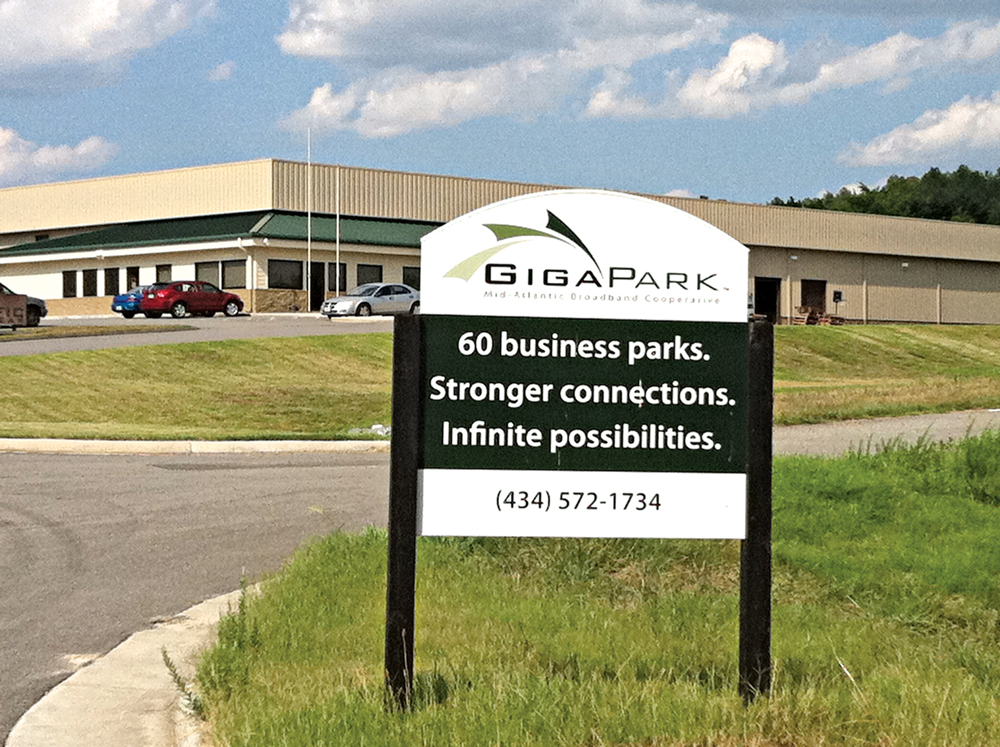
Signs like the one shown above, are used to showcase the 60 GigaParks throughout Southern Virginia.
These leaders conceived the idea of an open-access broadband network that would become what is known as today as Mid-Atlantic Broadband.
The concept was based on four key thoughts: 1) Build a network to bring competition and let the private sector telecom providers do what they do best. 2) Provide open access to the network and level the playing field. 3) Create a sustainable organization and keep expenses in line with revenues. 4) Provide flat rate pricing based on bandwidth, not distance.
Why are GigaParks more conducive for business?
In 2008, MBC expanded the capacity of its fiber-optic broadband network across 60 business, industrial and technology parks. Because of their access to MBC’s state-of-the-art connectivity and ability to provide high capacity connections at low costs, these parks were designated as “GigaParks” in January 2009.
GigaParks now feature a number of advantages for businesses looking to locate their operations in the United States:
- An advanced 400 gigabit-per-second low latency backbone network to key Tier 1 peering points in Northern Virginia and the Southeast;
- Low power and bandwidth costs;
- Extremely competitive tax rates;
- Low construction costs and costs per square foot for space;
- A wide range of real estate inventory, including fully built, expandable and greenfield sites;
- A highly dedicated and skilled work force;
- Robust power and network redundancy;
- Access to multiple major fiber-optic and telecom service providers at each GigaPark;
- Located in Virginia, named “The Best State for Business” by Forbes.com four years in a row and the “Top State for Business” by CNBC in 2009 and 2011; and
- Virginia’s GigaParks are perfectly placed near major markets like Washington, D.C.; Richmond, Va.; Raleigh/Research Triangle Park, N.C., and beyond, with easy access to major Interstates, including I-95, I-81 and I-85, as well as the abundance of international airports the area has to offer.
Recently, the reach of the GigaPark initiative has expanded into Southwest Virginia and now offers potential tenants approximately 100 locations from which to choose.
Success of MBC drives regional economic development success
Today MBC owns and operates a 1,500-mile carrier-class optical network powered regionally by Ciena optical electronics and Infinera digital optical electronics for long-haul operations. This advanced fiber optic network has provided many successes for MBC, GigaParks, and economic development in Southern and Southwest Virginia. The two most recent successes announced were: Microsoft beginning their next generation data center project with an investment of $500 million in the region, and ICF International expanding to Henry County, with an operations center that will create 500+ jobs in Southern Virginia.
MBC is seeing a tremendous growth in prospects that are now considering new operations in this region with high capacity and low costs. Because of the strategic infrastructure investments made by the Virginia Tobacco Commission, the Economic Development Administration, and most recently the National Telecommunications and Infrastructure Administration, we’re seeing positive momentum in our region. Both domestic and international investments are being targeted for our rural region, and we’re proud to be a part of the economic growth which has been made possible by advanced open-access optical backbone networks.
Capitalize on a Little-Known Secret
From its understated exterior, Banbury Place in Eau Claire, WI looks anything but high-tech. Situated in the city’s downtown among the scenic rolling hills of western Wisconsin, this former warehouse goes unnoticed by many. Inside, however, is a little known secret: a state-of-the-art data center with direct fiber connection to Minneapolis and Chicago.
Full-Service or Container Data Center Options
Wisconsin Independent Network (WIN) calls Banbury Place home and operates a data center in this discrete location. The company also owns and operates the most reliable, dense and redundant data transport system in the upper Midwest. With these assets, WIN offers a unique value proposition to its customers — customizable data center options from a full-service model with highly-skilled, local IT support to a “set it and forget it” container style option and everything in between. Wisconsin Independent Network can support companies by providing actual production IT infrastructure or simply a back-up site.
A Safe Place — for You and Your Data
When it comes to your company’s data, your employees and their families, safety and security are critical.Eau Claire, WI is ranked as a low-risk area for natural disasters. The area’s crime rate is far lower than major metropolitan areas. In addition, five colleges and universities provide a highly trained workforce at affordable wages and the cost of living is nine percent lower than the national average.